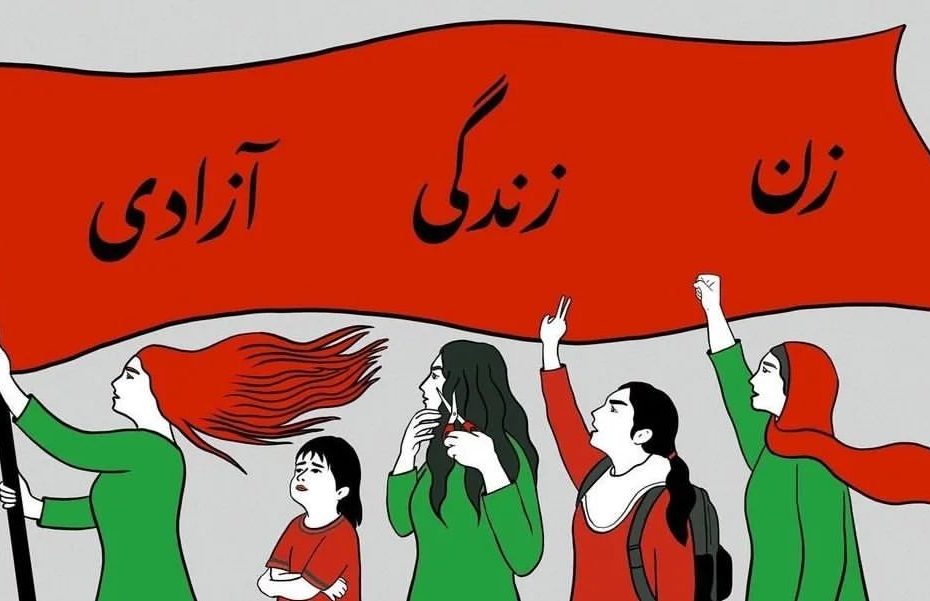On 16 September 2022, Mahsa Amini, a Kurdish-Iranian woman, was killed by the Iranian morality police due to her ‘improperly worn hijab’. Her death triggered a massive public response, as the streets of Iran began flooding with protestors who expressed their outrage at Amini’s untimely death as well as the state of women’s rights in the country. As the protests expanded beyond the region of Amini’s hometown in Kurdistan Province, the government’s violent crackdown on protesters has resulted in the death of an estimated 326 civilians, with at least 58 amongst this number being children. Nonetheless, as the situation continues to escalate, and the voices of the people are not silenced by the sounds of active repression, the protests have been acclaimed as the first counter-revolution led by women, marking a turning point for Iranian women.
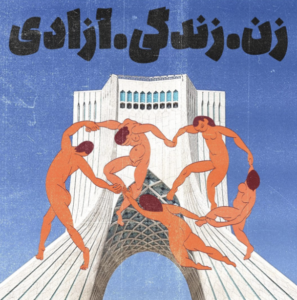 As the protests gain steam all over the world, art has emerged as a means of uniting the protestors and amplifying their message. Musicians have played a crucial role in the protests. A song by Shervin Hajipour was named the ‘anthem of the protests’ for its resonating lyrics. The women’s chant ‘Zan, Zindagi, Azaadi’ (Woman, Life, Freedom) has become emblematic with thousands of women taking to the streets challenging the state.
As the protests gain steam all over the world, art has emerged as a means of uniting the protestors and amplifying their message. Musicians have played a crucial role in the protests. A song by Shervin Hajipour was named the ‘anthem of the protests’ for its resonating lyrics. The women’s chant ‘Zan, Zindagi, Azaadi’ (Woman, Life, Freedom) has become emblematic with thousands of women taking to the streets challenging the state.
Visual artists from Iran as well as Iranian diaspora in different parts of the world have contributed to the movement. The phrase Zan, Zindagi, Azaadi can be seen in the collage by Jalz that represents the slogan along with a rendition of Matisse’s women dancers (figure 1). In a spontaneous artistic demonstration in the Guggenheim museum in New York, 12 red banners with the words alongside Amini’s image were flung from the ceiling by the Anonymous Artist Collective for Iran (figure 2).
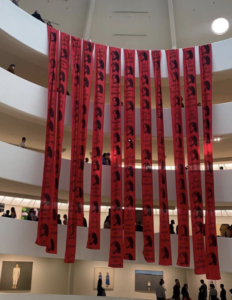 Moreover, visual artists, both from within Iran and the Iranian diaspora, have ensured the sounds of the protests are translated onto their own artwork.
Moreover, visual artists, both from within Iran and the Iranian diaspora, have ensured the sounds of the protests are translated onto their own artwork.
With Iranian art and politics becoming increasingly intertwined as the protests continue, an 11th-century Persian epic titled “Shahnameh” has been invoked to simultaneously inspire political and artistic movements. The text has served as the inspiration behind various artworks, as well as the political movement of women cutting their hair as a show of solidarity with Iranian women. Throughout the “Shahnameh” epic, which chronicles the creation of the world and the Muslim conquests of the 7th century, hair is seen as a recurring motif and is often torn or cut to signify mourning or loss. Therefore, the act of cutting one’s hair became a globally recognized form of expression for grief and unity against repressive tactics of the Iranian government.
Extracts from the epic also appear in the contemporary artist Meysam Azarzad’s work, where she juxtaposes the literary texts with her designs inspired by the protests. (figure 3) The poster on the left reads: “Once my father realizes that you’ve slain me, he will seek revenge.” On the right: “This massive army is useless. Indeed, a single fighting girl is worth hundreds of thousands of them.” Through linking the political movement with national literature, the current resistance efforts are given an emotional dimension based on a shared cultural heritage. Literature and art become a uniting force for the people of Iran, strengthening their solidarity and urging them to continue fighting for their right to freedom.
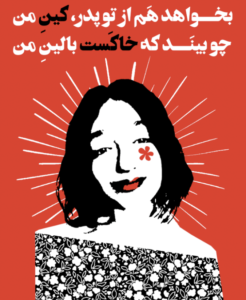
With the social and political impact art carries, artists have become clear targets for Iranian security forces. Among the most discussed cases has been the arrest of Shervin Hajipour on 29 September 2022, after his protest song, “Baraye,” became an anthem for the uprisings in Iran. Despite his release within the following week, Hajipour’s current well-being continues to be a matter of question. Various poets such as Atefeh Chaharmahalian, Behrouz Yasemi and Saeed Heleichi have been arrested for arbitrarily defined crimes such as ‘reciting poetry about Mahsa Amini’, and as a consequence are currently held prisoner in Iranian prisons. As the Iranian authorities attempt to combat the protests with violence and fear, many Iranians are calling for the rest of the world to add their voice to the movement. Art’s power to bring attention to the Iranian people’s struggle for freedom keeps the conversation alive and allows ideas to be exchanged beyond borders.
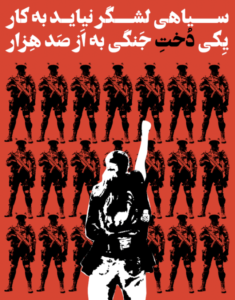 Artists have been and continue to be specifically targeted by regimes for their transformative power in influencing social change. Art appeals directly to emotion – it moves and inspires to continue fighting. Throughout the women’s protests in Iran have been ongoing, the art that has been created continues to be a form of representation and support for those who put their lives at risk to defend their ideals, as well as a platform to express their pain, struggle and hopes for the future of Iran.
Artists have been and continue to be specifically targeted by regimes for their transformative power in influencing social change. Art appeals directly to emotion – it moves and inspires to continue fighting. Throughout the women’s protests in Iran have been ongoing, the art that has been created continues to be a form of representation and support for those who put their lives at risk to defend their ideals, as well as a platform to express their pain, struggle and hopes for the future of Iran.
AGL stands in solidarity with the women of Iran and their right to express themselves in any manner they choose to do so. We stand with the artists who continue to challenge majoritarian norms and are available to provide assistance and support to artists in situations of increased vulnerability. We encourage such artists to reach out to us by filling this form here.
Author: Mayra Kost
As a current undergraduate student at Science Po, Mayra is an aspiring journalist passionate about reporting political and artistic news from around the globe. Pursuing a degree in Middle Eastern and North African studies, she is particularly interested in examining the interactions between politics and art within the region.
Bibliography
- Deep concern over multiple arrests of writers, artists, musicians in Iran, related to repression of mass protests since September (2022) PEN America. Available at: https://pen.org/press-release/deep-concern-over-multiple-arrests-of-writers-artists-musicians-in-iran-related-to-repression-of-mass-protests-since-september/
- Karimi, P. (2022) The many shades of Iran’s protest art, Hyperallergic. Available at: https://hyperallergic.com/768539/the-many-shades-of-iran-protest-art/
- Mendonca, D. et al. (2022) At least 326 killed in Iran protests, Human Rights Group claims, CNN. Cable News Network. Available at: https://edition.cnn.com/2022/11/12/middleeast/iran-protests-death-toll-intl-hnk/index.html#:~:text=Iranians%20protest%20the%20death%20of,in%20Tehran%2C%20on%20October%2027
- News, V.O.A. (2022) Iranian protesters mark 40 days since Mahsa Amini’s death, VOA. Voice of America (VOA News). Available at: https://www.voanews.com/a/iranian-protesters-mark-40-days-since-mahsa-amini-s-death-/6806212.html#:~:text=Rights%20groups%20say%20more%20than,Islamic%20Republic%20in%20its%20history.
- Proctor, R.A. (2022) Iranian artists react with outrage, calling for solidarity as protests over women’s rights spread globally, Artnet News. Available at: https://news.artnet.com/art-world/iranian-artists-protests-2182204
- Wright, R. (2022) Iran’s protests are the first counter-revolution led by women, The New Yorker. Available at: https://www.newyorker.com/news/daily-comment/irans-protests-are-the-first-counterrevolution-led-by-women
- (c) Instagram: @innerjalz. Jalz’s Protest Poster, captioned #women #life #Freedom (#زن #زندگی #آزادی)
- (c) Instagram: @shirin_neshat.
- (c) Instagram: @az.me.zad (Meyzam Azarzad)
- Title Image – (c) Instagram: @roshi_rouzbehani

